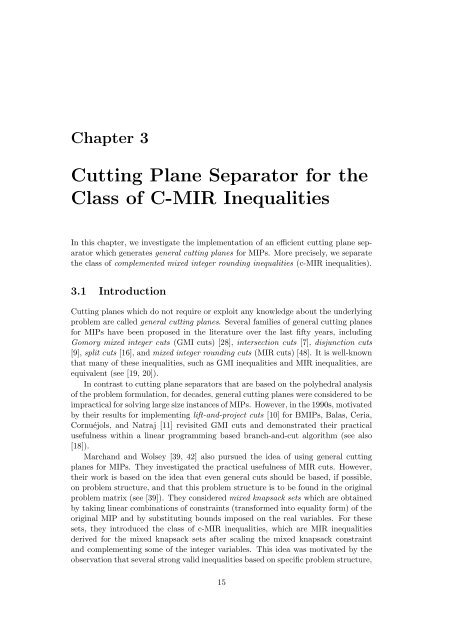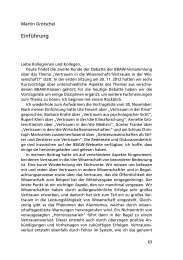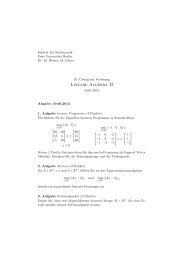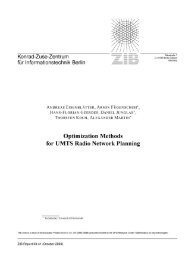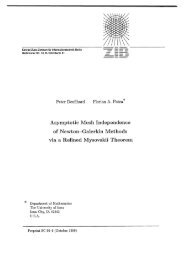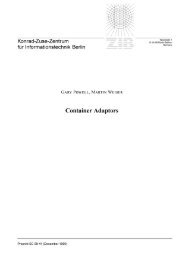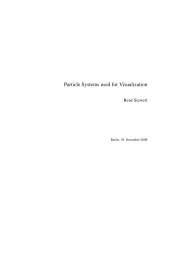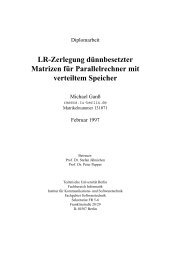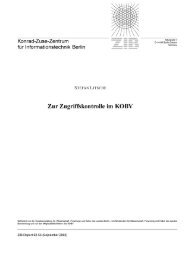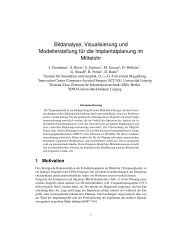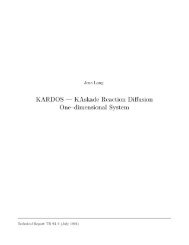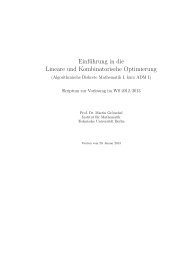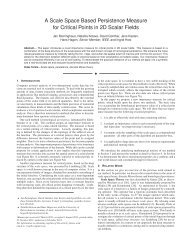Implementation of Cutting Plane Separators for Mixed Integer ... - ZIB
Implementation of Cutting Plane Separators for Mixed Integer ... - ZIB
Implementation of Cutting Plane Separators for Mixed Integer ... - ZIB
You also want an ePaper? Increase the reach of your titles
YUMPU automatically turns print PDFs into web optimized ePapers that Google loves.
Chapter 3<br />
<strong>Cutting</strong> <strong>Plane</strong> Separator <strong>for</strong> the<br />
Class <strong>of</strong> C-MIR Inequalities<br />
In this chapter, we investigate the implementation <strong>of</strong> an efficient cutting plane separator<br />
which generates general cutting planes <strong>for</strong> MIPs. More precisely, we separate<br />
the class <strong>of</strong> complemented mixed integer rounding inequalities (c-MIR inequalities).<br />
3.1 Introduction<br />
<strong>Cutting</strong> planes which do not require or exploit any knowledge about the underlying<br />
problem are called general cutting planes. Several families <strong>of</strong> general cutting planes<br />
<strong>for</strong> MIPs have been proposed in the literature over the last fifty years, including<br />
Gomory mixed integer cuts (GMI cuts) [28], intersection cuts [7], disjunction cuts<br />
[9], split cuts [16], and mixed integer rounding cuts (MIR cuts) [48]. It is well-known<br />
that many <strong>of</strong> these inequalities, such as GMI inequalities and MIR inequalities, are<br />
equivalent (see [19, 20]).<br />
In contrast to cutting plane separators that are based on the polyhedral analysis<br />
<strong>of</strong> the problem <strong>for</strong>mulation, <strong>for</strong> decades, general cutting planes were considered to be<br />
impractical <strong>for</strong> solving large size instances <strong>of</strong> MIPs. However, in the 1990s, motivated<br />
by their results <strong>for</strong> implementing lift-and-project cuts [10] <strong>for</strong> BMIPs, Balas, Ceria,<br />
Cornuéjols, and Natraj [11] revisited GMI cuts and demonstrated their practical<br />
usefulness within a linear programming based branch-and-cut algorithm (see also<br />
[18]).<br />
Marchand and Wolsey [39, 42] also pursued the idea <strong>of</strong> using general cutting<br />
planes <strong>for</strong> MIPs. They investigated the practical usefulness <strong>of</strong> MIR cuts. However,<br />
their work is based on the idea that even general cuts should be based, if possible,<br />
on problem structure, and that this problem structure is to be found in the original<br />
problem matrix (see [39]). They considered mixed knapsack sets which are obtained<br />
by taking linear combinations <strong>of</strong> constraints (trans<strong>for</strong>med into equality <strong>for</strong>m) <strong>of</strong> the<br />
original MIP and by substituting bounds imposed on the real variables. For these<br />
sets, they introduced the class <strong>of</strong> c-MIR inequalities, which are MIR inequalities<br />
derived <strong>for</strong> the mixed knapsack sets after scaling the mixed knapsack constraint<br />
and complementing some <strong>of</strong> the integer variables. This idea was motivated by the<br />
observation that several strong valid inequalities based on specific problem structure,<br />
15


